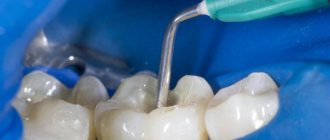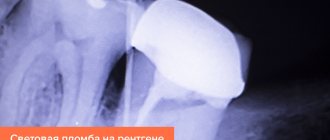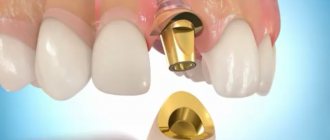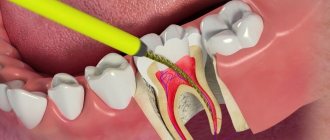Often dental treatment is not limited to just one visit to the doctor - in this case, at an intermediate stage, a temporary filling cannot be avoided. It is mainly used in the following cases:
- Treatment of acute deep caries. The border between dental tissues and the pulp chamber is so thin that the carious process can develop into pulpitis, and then root canal treatment will be required. Therefore, at the first visit, the dentist places a medicinal lining in the tooth and closes the cavity with a temporary filling. If the tooth continues to hurt under it, this indicates the need to change tactics.
- Treatment of pulpitis. In most cases, pulp inflammation is treated in two visits. First, it is necessary to necrotize the vessels and nerves so that later removal of the affected tissue and treatment of the canals will not be painful. To do this, during the first visit, a temporary filling with arsenic is placed.
- Treatment of periodontitis. Depending on the stage of the disease, medicine is placed into the root canals to stop the inflammatory process or to restore bone tissue (when a cyst is removed). In both cases, a temporary filling is needed. At each appointment, the dentist checks the condition of the root canals, as well as the tissues adjacent to it, and decides whether it is possible to permanently fill the tooth or whether it is worth putting a new portion of the drug.
- Preparation for prosthetics. In some situations, a temporary filling is placed on already cured and filled canals - for example, before installing a pin or orthopedic structure.
Composition of temporary filling
The main difference between temporary fillings and permanent fillings is their composition. They are usually made from the following materials:
- Artificial dentin. This is a mixture of zinc oxide and sulfate powders with distilled water.
- Vinoxol. It is a mixture of zinc oxide powder and liquid. It has good adhesion and antiseptic properties, and due to its high strength, a temporary filling made from this material can last up to six months.
- Dentine paste. White homogeneous mass with essential oils. The material is plastic, has excellent adhesion, and has water-repellent properties.
- Zinc-eugenol cement. It contains zinc oxide and clove oil or the fragrant substance eugenol. A temporary filling made from this material has good adhesion, an analgesic effect, antiseptic properties, and resistance to increased loads.
- Polycarboxylate cement. It is a mixture of zinc oxide powders, copper and liquid. It has good ductility, resistance to moisture, and excellent adhesion.
- Karyosan - zinc oxide with eugenol.
All materials have their own hardening time and the period after which food can be eaten. For each case, the dentist himself determines the type and composition for filling the cavity, which will affect the price of the temporary filling.
Arsenic-free pastes
With pastes without arsenic, the situation is much simpler: even with prolonged use, periodontitis does not occur so quickly, although you should not exceed the time prescribed by the doctor!
Arsenic-free pastes are even used to treat children. Thus, the treatment is intermittent and the child does not have to stay in the chair for a long time. And also, which is very important, it is possible to do without injections.
For the adult population, root canal treatment is successfully carried out under anesthesia, on average in 1-3 visits, depending on the complexity of the situation.
How much does a temporary filling with arsenic cost?
The period for which a temporary filling with arsenic can be left in a tooth depends on various circumstances - the age of the patient, the condition of his teeth, as well as the means used by the dentist to kill the pulp. When setting the time frame, the option of placing the drug is also taken into account - on an unopened pulp chamber or directly on the exposed pulp.
Typically, a temporary filling with arsenic remains in the tooth for a day, but when treating multi-channel chewing teeth, this period can be increased to two days. When treating baby teeth with formed roots, this time is reduced to 18 and 24 hours, respectively. And if the latest generation of arsenic preparations are used, they can be left in the tooth for up to five days.
If you have been given a temporary filling with arsenic, you must strictly adhere to the deadlines and come to replace it at the time specified by the doctor. Prolonged residence of the drug in the tooth leads to the penetration of arsenic into neighboring tissues and its accumulation there, which can ultimately provoke periodontal inflammation.
Arsenic in the tooth
In most cases, toothache comes suddenly and a person is forced to put aside all his affairs and visit the dentist. Some people always associate dental treatment with pain and they think with fear about the upcoming visit to the doctor and try to postpone it indefinitely. But you cannot delay visiting the dentist, as the disease will develop further, and this entails the risk of complications.
In the process of dental treatment, specialists at the Costamed dental clinic use fast, painless and well-proven methods. But there are cases when the only possible option for removing the nerve is the use of arsenic.
Why do they put arsenic in the tooth?
Arsenic is administered in order to get rid of the dental nerve, which in turn causes pain in a number of dental diseases. The drug has a necrotic effect on the nerve, pulp and nerve endings through a direct cytotoxic effect on cells. It causes disruption of cell respiration, denaturation of pulp proteins, stops its blood supply, blocks the transmission of impulses that come from nerve endings, and leads to cell death.
Indications for using arsenic in teeth:
- Allergic reaction to anesthetic.
- Limited time.
- Treatment by the doctor on duty due to urgent indications.
- The body's immunity to the effects of anesthetics.
- Inability to administer anesthesia due to the patient's health.
- Dental treatment in children when it is impossible to use local anesthesia.
How dangerous is the use of arsenic?
The product used in Perm dentistry is not pure arsenic, but its derivative. It is placed deep into the tooth, and the specialist will put a filling on top, so the paste will not get into the stomach or blood. Even if a patient’s filling accidentally falls out and he swallows it, this will also not cause harm to his body, since the proportion of arsenic contained in the paste is minimal.
Consequences of untimely removal of arsenic from a tooth
Arsenic is a poison. Even though its concentration in the paste is low, if it is not removed in a timely manner, it can cause an inflammatory process in the tooth tissues. The consequences can be very negative; the patient may develop diseases such as periodontitis or periostitis.
Please note that a temporary filling may fall out on its own or last for about 6 months or even a year.
Some patients are confident that if they do not feel pain, they may not visit the dentist again, and continue to walk with arsenic in their teeth. This should absolutely not be done, since with prolonged contact with tissues, the paste will gradually poison the entire body. Doctors apply the paste for a certain period of time; during this period it cannot cause significant harm. The next visit is scheduled to remove the paste from the tooth and place a permanent filling.
Contact the Costamed clinic with any problems related to health and oral diseases. You can make an appointment with a dentist using the online appointment form or call. Registration is made 24 hours a day. Call now!.
Dentist's recommendations after treatment of caries, pulpitis and periodontitis
Do not eat before the anesthesia wears off.
There is no need to worry if after caries treatment there is sensitivity in the tooth, spontaneous minor pain, or discomfort when biting on the tooth. Usually these sensations disappear within 2-3 days to 1-2 weeks.
Be sure to contact your dentist if:
- after the anesthesia wears off, the filling interferes with the teeth closing;
- after treatment of a tooth for caries or pulpitis (periodontitis), acute, paroxysmal pain occurred that occurs spontaneously, as well as pain that increases over time;
- unpleasant sensations occurred while eating sweet, sour, cold or hot foods;
- swelling of the gums around the treated tooth is detected
Filled teeth should be brushed with a toothbrush and toothpaste in the same way as natural teeth - at least twice a day. After eating, you should rinse your mouth to remove any remaining food. Use dental floss to clean the interdental spaces after learning how to use them and on the recommendation of a doctor. It is advisable to use an irrigator.
If you have fillings made of composite materials, you should not eat food containing natural and artificial colors (blueberries, tea, coffee, etc.) during the first two days after filling the tooth. Following this diet will help avoid darkening of the filling.
To avoid chipping the filling and the hard tooth tissue adjacent to the filling, it is not recommended to eat and chew very hard foods (nuts, crackers), or bite off large pieces (for example, a whole apple)
A pulpless tooth is deprived of blood supply and innervation, so special attention is required to protect its enamel from caries, abrasion, darkening, chips and cracks. One way is to place a crown on such a tooth in the next three months. The main means of preserving pulpless teeth: maintaining the body’s general resistance to infections, careful oral hygiene, professional hygiene and prevention in the dental clinic, rational prosthetics to evenly distribute the chewing load.
To monitor the condition of the bone tissue around the roots of the teeth where canal treatment was performed, six months after treatment, or at the time prescribed by the attending physician, you need to take an x-ray.
Visit your dentist at least once every six months for preventive examinations and hygiene measures, as well as polishing the filling, which will increase its service life.
What can happen after installing a temporary filling?
In some cases, patients experience pain after placing temporary filling material into the tooth cavity. Mild pain during the first 5 days after the intervention is considered normal. If pain intensifies, you should immediately consult a doctor. Violation of this rule can lead to the development of various diseases and tooth loss.
It is normal to have a smell or taste of medication in the mouth after the procedure. The sudden appearance of a strong smell or taste of medicines indicates depressurization of the filling and leaching of medicines with saliva from the tooth cavity. Some drugs, if they enter the oral cavity, can have a negative effect on the human body. If such signs appear, you should immediately contact a specialist.
Swelling of the gums, darkening of tooth enamel, and the appearance of bad breath indicate the development of diseases. If symptoms appear, you should contact your dentist immediately. The doctor will remove the filling material and carry out diagnostic measures. You may need to contact your dentist if the filling breaks. Failure to visit a specialist in a timely manner will result in food particles and bacteria entering the tooth cavity.
When is a temporary filling placed?
The situations in which a temporary fix is required are the same for adults and children:
- Diagnosis of deep caries. If the tooth is severely damaged, the doctor may install a temporary filling to determine whether or not the pulp needs to be removed. If the neurovascular bundle is not affected, the patient will feel comfortable. If the pulp is damaged, he will experience toothache, and in this case he will have to remove the neurovascular bundle, and then install a permanent filling.
- Treatment of pulpitis. To remove the pulp, the doctor can put a devitalizing paste inside the tooth and close the cavity with a temporary filling. After 1-7 days, a second visit to the dentist is necessary for further manipulations. In addition, it is advisable to install a “temporary cavity” after filling the canals with gutta-percha and sealant, if the dentist will install a pin or stump inlay, and also if there is a risk of exacerbation of inflammation.
- Treatment of periodontitis. Now it is possible to treat the pathology in 1 visit to a specialist. But in order to get a more predictable result, it is advisable to first eliminate the source of inflammation, then fill the tooth canals. In this case, a preparation based on calcium hydroxide is placed under the “temporary bark”, the period of action of which is from 1 to 4 weeks. After this, you need to place a new portion of the drug.
- Preparing teeth for prosthetics. In this case, the “makeshift” serves to protect the canals from food and pathogenic microorganisms entering them. The patient wears this filling until the dentures are made.
There are times when a doctor or patient does not have time to perform all the necessary procedures in one visit. Then the dentist will install a “temporary window” and name the date of the next visit.











